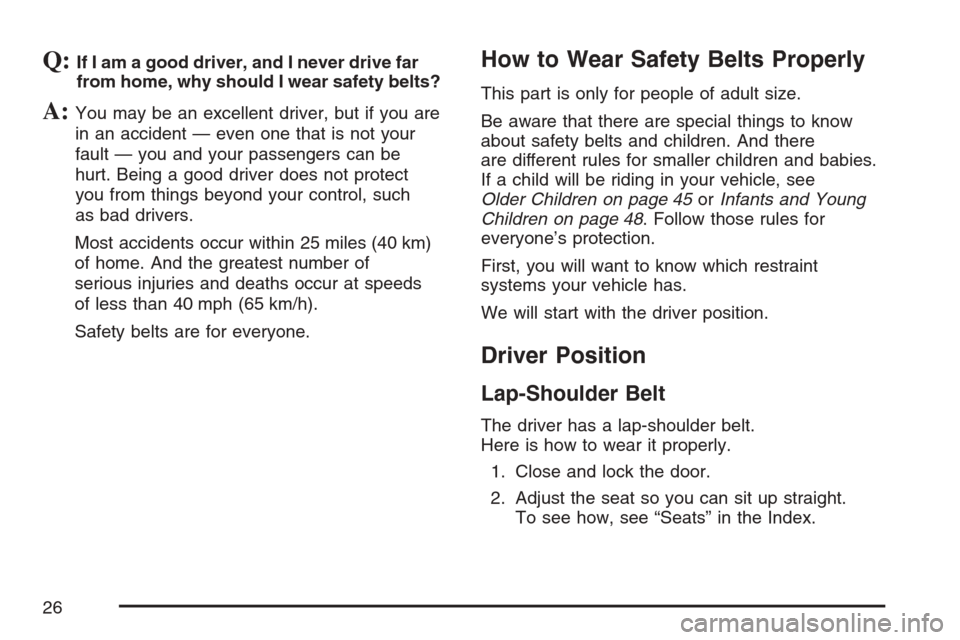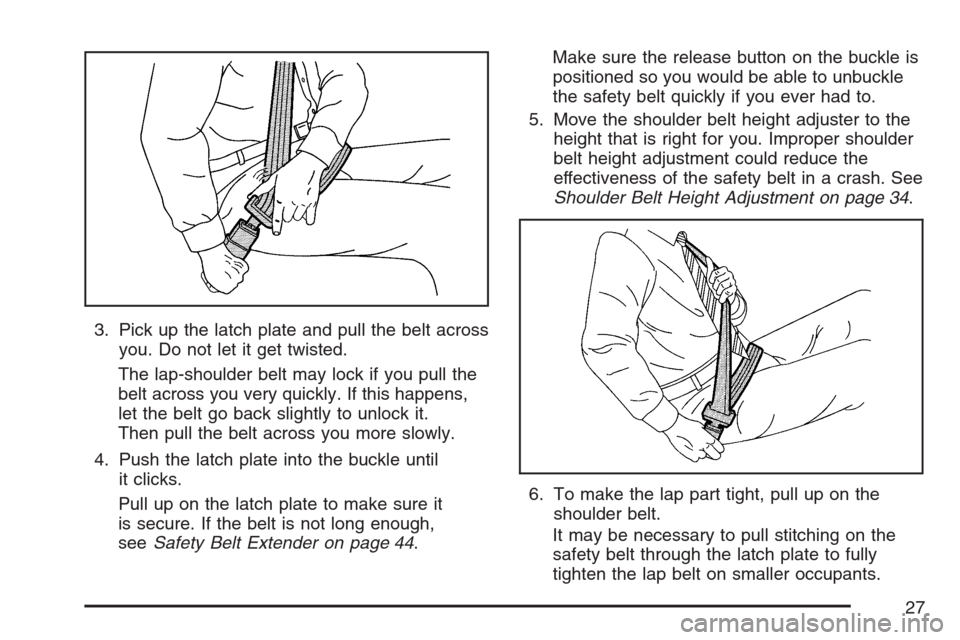Page 1 of 618

Seats and Restraint Systems
....................... 7
Front Seats
.............................................. 9
Rear Seats
............................................. 19
Safety Belts
............................................ 21
Child Restraints
...................................... 45
Airbag System
........................................ 72
Restraint System Check
......................... 88
Features and Controls
................................ 91
Keys
....................................................... 93
Doors and Locks
.................................. 102
Windows
............................................... 116
Theft-Deterrent Systems
....................... 118
Starting and Operating Your Vehicle
....... 122
Mirrors
.................................................. 145
OnStar
®System
................................... 156Universal Home Remote System
.......... 159
Storage Areas
...................................... 170
Sunroof
................................................ 199
Instrument Panel
....................................... 201
Instrument Panel Overview
................... 204
Climate Controls
................................... 227
Warning Lights, Gages, and
Indicators
.......................................... 239
Driver Information Center (DIC)
............ 257
Audio System(s)
................................... 286
Driving Your Vehicle
................................. 351
Your Driving, the Road, and
Your Vehicle
..................................... 352
Towing
................................................. 408
2007 Chevrolet Avalanche Owner ManualM
1
Page 9 of 618
Front Seats
Manual Seats
{CAUTION:
You can lose control of the vehicle if
you try to adjust a manual driver’s seat
while the vehicle is moving. The sudden
movement could startle and confuse you,
or make you push a pedal when you do
not want to. Adjust the driver’s seat only
when the vehicle is not moving.If your vehicle has a manual bucket or a split
bench seat, you can adjust the seat forward or
rearward with the bar located under the front of
the seat cushion.
Lift the bar to unlock the seat. Slide the seat to
where you want it and release the bar. Try to
move the seat with your body to be sure the
seat is locked in place.
9
Page 14 of 618

If something has blocked the driver’s seat and/or
the adjustable pedals while recalling a memory
position, the driver’s seat and/or the adjustable
pedals recall may stop working. If this happens,
remove the obstruction and press the appropriate
control for the area that is not responding for
two seconds. Try recalling the memory position
again by pressing the appropriate memory button.
If the memory position is still not recalling, see
your dealer for service.
Easy Exit Seat
The control for this feature is located on the
driver’s door panel between buttons 1 and 2.
With the vehicle in PARK (P), the driver’s seat exit
position can be recalled by pressing the exit
button. You will hear a single beep, and the
driver’s seat will move back.
If the easy exit seat feature is programmed in the
Driver Information Center (DIC), automatic
seat movement will occur when the key is removed
from the ignition. See “EASY EXIT SEAT” under
DIC Vehicle Customization (With DIC Buttons)
on page 278for more information.The memory seat and easy exit features can also
be programmed using the DIC.
For programming information, seeDIC Vehicle
Customization (With DIC Buttons) on page 278.
Reclining Seatbacks
Manual Reclining Seatbacks
{CAUTION:
You can lose control of the vehicle if
you try to adjust a manual driver’s seat
while the vehicle is moving. The sudden
movement could startle and confuse you,
or make you push a pedal when you do
not want to. Adjust the driver’s seat only
when the vehicle is not moving.
14
Page 15 of 618
{CAUTION:
If the seatback is not locked, it could
move forward in a sudden stop or crash.
That could cause injury to the person
sitting there. Always push and pull on
the seatback to be sure it is locked.
If the seats have manual reclining seatbacks,
the lever used to operate them is located on the
outboard side of the seat(s).
To recline the seatback, do the following:
1. Lift the recline lever.
2. Move the seatback to the desired position,
then release the lever to lock the seatback
in place.
3. Push and pull on the seatback to make sure
it is locked.
15
Page 16 of 618
To return the seatback to an upright position,
do the following:
1. Lift the lever fully without applying pressure
to the seatback and the seatback will return
to the upright position.
2. Push and pull on the seatback to make sure
it is locked.Power Reclining Seatbacks
If the seats have power reclining seatbacks,
the control used to recline them is located on
the outboard side of the seat behind the power
seat control.
To recline the seatback, tilt the top of the
control rearward.
To bring the seatback forward, tilt the top
of the control forward.
Driver’s Seat with Power Seat Control,
Power Recline, and Power Lumbar shown
16
Page 20 of 618
To return the seats to the normal position, push
the seatback up and fold the seat cushion down.
{CAUTION:
A safety belt that is improperly routed,
not properly attached, or twisted will not
provide the protection needed in a crash.
The person wearing the belt could be
seriously injured. After raising the rear
seatback, always check to be sure that
the safety belts are properly routed and
attached, and are not twisted.
{CAUTION:
If the seatback is not locked, it could
move forward in a sudden stop or crash.
That could cause injury to the person
sitting there. Always be sure to press the
rear of the seat cushion down. This action
locks the seatback in place.
Push and pull on the seatback to make sure
it is locked. Raise the head restraint.
20
Page 26 of 618

Q:If I am a good driver, and I never drive far
from home, why should I wear safety belts?
A:You may be an excellent driver, but if you are
in an accident — even one that is not your
fault — you and your passengers can be
hurt. Being a good driver does not protect
you from things beyond your control, such
as bad drivers.
Most accidents occur within 25 miles (40 km)
of home. And the greatest number of
serious injuries and deaths occur at speeds
of less than 40 mph (65 km/h).
Safety belts are for everyone.
How to Wear Safety Belts Properly
This part is only for people of adult size.
Be aware that there are special things to know
about safety belts and children. And there
are different rules for smaller children and babies.
If a child will be riding in your vehicle, see
Older Children on page 45orInfants and Young
Children on page 48. Follow those rules for
everyone’s protection.
First, you will want to know which restraint
systems your vehicle has.
We will start with the driver position.
Driver Position
Lap-Shoulder Belt
The driver has a lap-shoulder belt.
Here is how to wear it properly.
1. Close and lock the door.
2. Adjust the seat so you can sit up straight.
To see how, see “Seats” in the Index.
26
Page 27 of 618

3. Pick up the latch plate and pull the belt across
you. Do not let it get twisted.
The lap-shoulder belt may lock if you pull the
belt across you very quickly. If this happens,
let the belt go back slightly to unlock it.
Then pull the belt across you more slowly.
4. Push the latch plate into the buckle until
it clicks.
Pull up on the latch plate to make sure it
is secure. If the belt is not long enough,
seeSafety Belt Extender on page 44.Make sure the release button on the buckle is
positioned so you would be able to unbuckle
the safety belt quickly if you ever had to.
5. Move the shoulder belt height adjuster to the
height that is right for you. Improper shoulder
belt height adjustment could reduce the
effectiveness of the safety belt in a crash. See
Shoulder Belt Height Adjustment on page 34.
6. To make the lap part tight, pull up on the
shoulder belt.
It may be necessary to pull stitching on the
safety belt through the latch plate to fully
tighten the lap belt on smaller occupants.
27